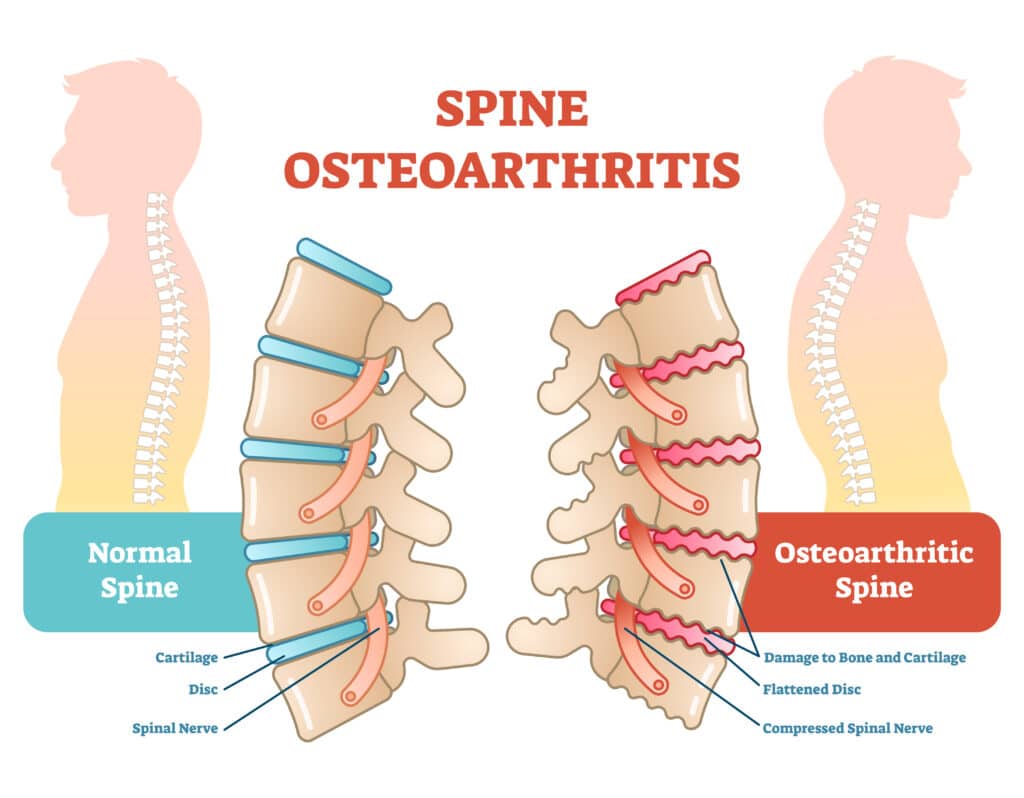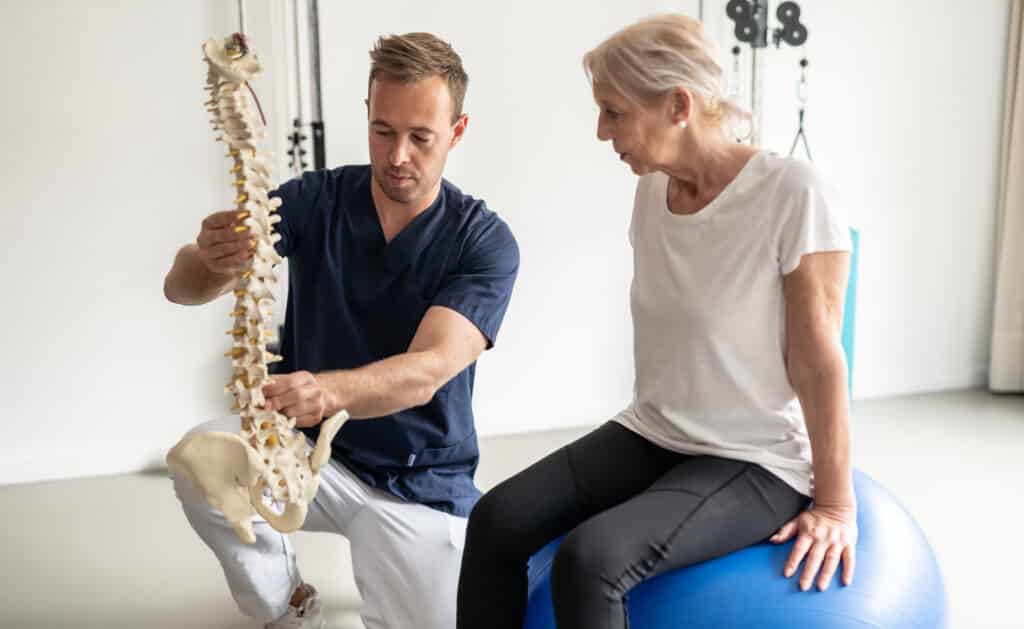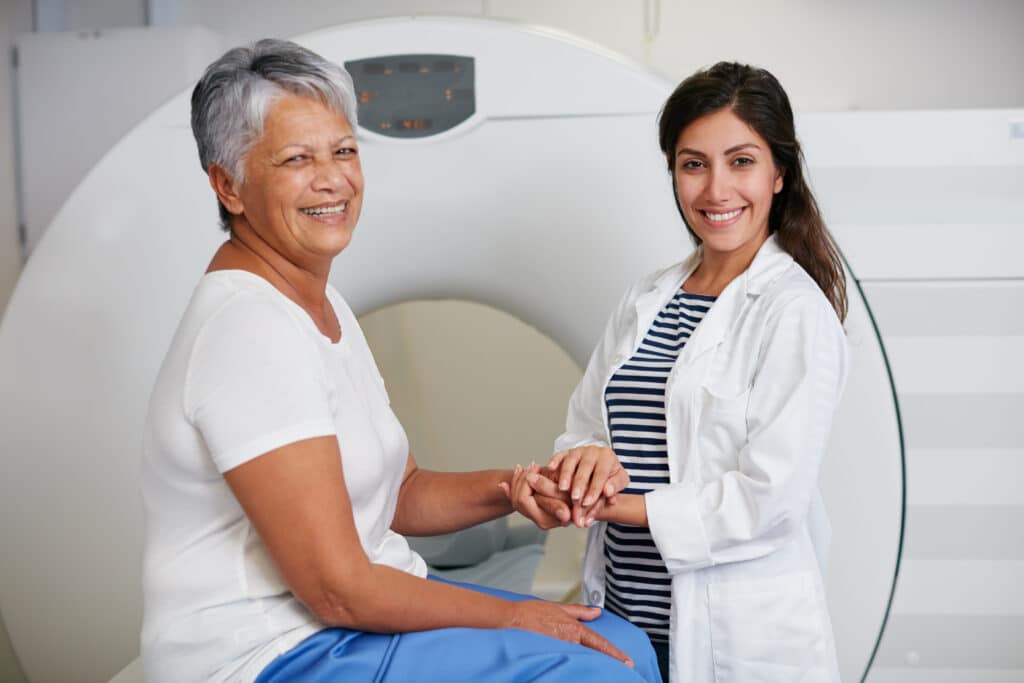Osteoporosis can significantly increase the risk of spinal fractures and other complications. Spinal fractures from osteoporosis are more common than you may realize—and not just for seniors. An estimated 700,000 people (equal to about half the population of Hawaii) are diagnosed in the U.S. annually.
Table of Contents
- Understanding Spinal Fractures from Osteoporosis
- Different Types of Osteoporotic Spinal Fractures
- Lifestyle Factors that Influence Osteoporosis
- Common Complications from Fractures
- Screening for Osteoporosis of the Spine
- Treatment Options for Spinal Fractures
- Prevention Methods for Osteoporosis
- Key Takeaways
- FAQ
An osteoporosis diagnosis can be daunting, but even if you’ve been diagnosed with osteoporosis, there are steps you can take. This article will give you a comprehensive understanding of osteoporosis-induced spinal fractures, their prevention, diagnosis, and treatment, so you can stay on top of this all-too-common condition.
Understanding Spinal Fractures from Osteoporosis

Osteoporosis is a bone disease characterized by bone weakening and brittleness. The condition results from bone loss, inadequate new bone formation, or both.
As a result, the bones become so frail that even a minor fall or regular activities like bending or coughing can cause a fracture. Osteoporosis predominantly affects older women but can also occur in men, so getting screened is essential regardless of gender.
Spinal fractures are a significant and worrisome complication of osteoporosis. They occur when one or more vertebrae, the bones that constitute your spine, break. Most often, they occur in the lower part of the spine, known as the lumbar region.
Spinal fractures due to osteoporosis may not initially present noticeable symptoms. However, they can lead to chronic pain, reduced mobility, nerve damage, or spinal deformities if left untreated.
Severe fractures may become evident if you experience sudden and severe pain, numbness, weakness in your back or legs, difficulty breathing, and loss of bladder or bowel control. These symptoms require immediate medical attention.
Diagnosis and Treatment of Spinal Fractures from Osteoporosis
Suppose you are experiencing these symptoms and have previously been diagnosed with osteoporosis. In that case, consulting with your doctor is a good idea. They will take your medical history, conduct a physical exam, and order tests to confirm the diagnosis and create a treatment plan specific to you and your lifestyle.
Diagnosis may involve taking X-rays, CT scans, and bone density tests. The choice of treatment depends on the type and severity of the fracture, your symptoms, your overall health, and your preferences. Treatment options include pain medication, physical therapy, braces, and in severe cases, surgery.
While we’ll cover many of these topics in more detail later in this article, it’s important to highlight that early treatment for spinal fractures—or any other serious complications from osteoporosis—is essential. Don’t wait until your discomfort becomes worse.
Preventing Spinal Fractures from Osteoporosis
Prevention is always better than seeking a cure after being diagnosed.
Later, we’ll make recommendations about how a balanced diet, supplementation, regular exercise, and living a healthy lifestyle can aid you in maintaining bone health.
It’s essential to recognize the risk factors of spinal fractures from osteoporosis. These include your age and gender, family history of diagnosis, low body weight, smoking and alcohol use, other chronic diseases, certain medications, and previous fractures.
Knowing these factors will help you take necessary preventive measures. Let’s look at a real-life scenario with one of my previous patients for perspective.
Spinal Osteoporosis Fracture: A Patient’s Story

Take the case of an elderly female patient who came into my clinic complaining of constant mid-back pain that worsened with coughing.
Her examination revealed an increased thoracic kyphosis, muscle spasms, and pain in the lower thoracic spine. Despite no history of osteoporosis or trauma, suspicion of a spinal fracture led to her being referred for X-rays. The tests confirmed a fracture in the middle of her back, which led to her osteoporosis diagnosis.
After her fracture healed, preventative treatment focused on improving her nutrition and regular exercise, such as stretching, strengthening, and weight-bearing activities to slow further bone loss and prevent associated complications.
Different Types of Osteoporotic Spinal Fractures
Different types of spinal fractures can occur for various reasons throughout the spine.
The most common type is a wedge fracture, which occurs when the front part of a vertebra collapses, forming a wedge shape. This can cause the spine to curve forward, creating a kyphosis-like humpback appearance.
Another type is a biconcave fracture, which happens when both the front and back parts of a vertebra collapse, forming a concave shape. This can cause the spine to lose height and become shorter.
A third type is a crush fracture, where the entire vertebra collapses and forms a flat shape. This can destabilize the spine and compress the spinal cord or nerves.
If you experience symptoms or have risk factors for spinal fractures from osteoporosis, consult your doctor as soon as possible. Your doctor will inquire about your medical history, perform a physical exam, and order tests to diagnose your condition and determine the best treatment.
Let’s take a deeper dive into the methods used to diagnose osteoporosis of the spine and the factors and treatment methods that can prevent it from worsening.
Lifestyle Factors that Influence Osteoporosis
In addition to preventing osteoporosis and its progression, you should also be aware of the risk factors and complications of spinal fractures from osteoporosis.
Here are some of the more common risk factors for osteoporosis:
Age & Gender
Your risk of spinal fractures from osteoporosis increases as you age, especially after menopause for women and after age 70 for men. Women are more likely than men to develop osteoporosis and spinal fractures due to hormonal changes during menopause that cause rapid bone loss.
Family history
If you have a parent or sibling with osteoporosis or a history of fractures, you may have a higher risk of developing the same condition.
For example, if your mother was previously diagnosed, and you share a similar body shape, it is a good idea to get screened early.
Low body weight
Low bodyweight has been extensively linked to the occurrence of osteoporosis. If you are underweight or have a low body mass index (BMI), you may have less bone mass and strength than average.
Smoking & Alcohol Use
Smoking can damage your bones and increase your risk of osteoporosis and fractures. Alcohol can affect your bone health and increase your risk of osteoporosis and fractures.
Limiting or abstaining from these behaviors can improve your chances of deterring osteoporosis and many other chronic diseases.
Chronic Diseases
Some diseases that affect your endocrine system (such as diabetes, thyroid disorders, or Cushing’s syndrome), your digestive system (celiac disease, inflammatory bowel disease, or liver disease), your immune system (namely rheumatoid arthritis or lupus), or your nervous system (Parkinson’s disease or multiple sclerosis) can increase your risk of osteoporosis and spinal fractures.
Medications
Some medications used to treat certain conditions can also increase your risk of osteoporosis and spinal fractures. These include corticosteroids (such as prednisone), anticonvulsants (such as phenytoin), anticoagulants (such as warfarin), proton pump inhibitors (such as omeprazole), or aromatase inhibitors (such as anastrozole).
Previous Fractures
If you have had a previous fracture due to osteoporosis, you are more likely to have another one.
Common Complications from Fractures
Some common complications tend to arise alongside a fracture diagnosis. Here are some of the more common issues that people with spinal fractures tend to encounter:
Nerve damage
Spinal fractures from osteoporosis can compress or injure the spinal cord or nerves, causing numbness, tingling, weakness, or paralysis in your back or legs. This can affect your mobility, balance, and sensation, increasing your risk of falls and further fractures.
Spinal Deformity
Spinal fractures due to osteoporosis can cause your spine to curve forward and create a humpback appearance, also known as kyphosis [2]. This can affect your posture, breathing, digestion, and appearance, reducing your self-esteem and quality of life.
Chronic Pain
Spinal fractures caused by osteoporosis can cause chronic pain in your back or legs that can interfere with your daily activities and sleep. This can affect your mood, energy, and well-being and increase your risk of depression and anxiety.
Screening for Osteoporosis of the Spine

Getting screened for osteoporosis is the first step to taking action before the condition gets worse. Here are some of the most common tests you are likely to encounter while being treated for osteoporosis:
- X-rays: These images show the shape and alignment of your vertebrae and can reveal fractures or other structural problems in the spine’s bones.
- Magnetic Resonance Imaging (MRI): This test provides detailed images of your spinal bones and tissues and can detect fractures, infections, tumors, or nerve damage.
- Computed Tomography (CT) Scan: This test combines X-ray images from different angles to create cross-sectional views of your spine and can locate fractures, bone fragments, or spinal cord compression.
- Bone Density Test (DEXA Scan): This test measures the amount of bone mineral in a specific volume of bone and can diagnose osteoporosis or assess your risk of fractures.
It’s hard to be sure whether you have a bone condition like osteoporosis without getting properly tested. Schedule an appointment with your doctor to determine whether one of these tests is appropriate.
Treatment Options for Spinal Fractures
Treatment for spinal fractures from osteoporosis focuses on relieving pain, preventing further fractures, and improving mobility and quality of life. Depending on the type and severity of your fracture, your doctor may recommend one or more of the following treatment methods:
Medication
These may include pain relievers, bone-strengthening drugs (such as bisphosphonates or denosumab), hormone therapy (such as raloxifene or teriparatide), or calcium and vitamin D supplements.
Physical Therapy
This may involve exercises to strengthen your back muscles, improve your balance and coordination, and increase your flexibility and endurance.
While physical therapy may not directly address the damage to your bones, it can help to create stability, mobility, and strength in the muscles and tissues around them to decrease pain and improve function.
Bracing
This may include a back brace to support your spine, reduce pain, and prevent further fractures. Braces can often be helpful alongside physical therapy or other treatment methods to prevent postural issues arising from your condition.
Surgery
This may be necessary in severe cases to stabilize your spine, relieve pressure on your spinal cord or nerves, and restore your spine’s shape and height.
Procedures may include vertebroplasty or kyphoplasty, which involves injecting bone cement into the fractured vertebra, or spinal fusion, which involves joining two or more vertebrae.
Prevention Methods for Osteoporosis
While treatment is crucial, prevention is just as important. Even if you have been told that you are at risk for osteoporosis, it’s crucial to take action to get ahead of the disease before it worsens.
Here are some ways to protect your bone health and prevent spinal fractures from osteoporosis:
Eat a Balanced Diet Rich in Calcium and Vitamin D
Calcium and vitamin D are essential nutrients for your bones. Calcium helps build and strengthen your bones, while vitamin D helps your body absorb calcium and regulate bone growth.
You can get calcium and vitamin D from dairy products, green leafy vegetables, fish, eggs, or fortified cereals. You can also take supplements or medications if your diet is insufficient or you have a deficiency.
The table below shows the recommended daily calcium and vitamin D intake for different age groups:
| Age group | Calcium (mg/day) | Vitamin D (IU/day) |
| 19-50 | 1000 | 600 |
| 51-70 | 1200 | 600 |
| >70 | 1200 | 800 |
Regular Exercise
Exercise is good for your bones and your overall health. It can help increase bone density and strength, improve posture and balance, reduce the risk of falls and fractures, and relieve pain and stiffness.
You should aim for at least thirty minutes of moderate physical activity most days of the week. Some examples of bone-friendly exercises include weight-bearing exercises (such as walking or dancing), resistance exercises (such as lifting weights or using elastic bands), or balance exercises (think tai chi or yoga).
Resistance exercises like weight training can be particularly beneficial in promoting bone health to deter osteoporosis and other similar conditions.
Avoiding Smoking and Alcohol
Smoking and alcohol can harm your bones and increase your risk of osteoporosis and fractures. Smoking can interfere with your body’s ability to make new bones and reduce the blood supply to your bones. Alcohol can affect your body’s absorption of calcium and vitamin D and increase the production of hormones that break down bone.
As a preventative measure (and for general health reasons), it’s a good idea to quit smoking entirely and limit your alcohol intake to no more than one drink per day for women and two drinks per day for men.
Preventive Supplements & Medication
If you have osteoporosis or a high risk of developing it, talk to your doctor. Supplements or medications may help to prevent further bone loss and reduce your risk of fractures.
Different osteoporosis supplements or medications, such as bisphosphonates, hormone therapy, selective estrogen receptor modulators (SERMs), calcitonin, denosumab, or teriparatide, are available.
You should consult your doctor before taking supplements or medications. Many over-the-counter medicines may have side effects or interactions with other drugs.
It’s also important to remember that food labels and over-the-counter supplements are often false or misleading. Your doctor is your most reliable guide about what works and what doesn’t.
Bone Density Screening
Even if you are symptom-free, it’s best to get a bone density test if you are at risk of osteoporosis, especially if you are a woman over 65 or a man over 70. This test can diagnose osteoporosis early and allow you to start treatment before you have a fracture.
Key Takeaways
- Osteoporosis is a condition causing weakened bones that predominantly affects older women but also men, making them prone to fractures.
- There are approximately 700,000 cases of spinal fractures due to osteoporosis annually in the U.S.
- The early stages of osteoporosis-induced spinal fractures may have minimal symptoms.
- Severe fractures can cause severe pain, numbness, difficulty breathing, and loss of bladder or bowel control.
- Detection methods include medical history reviews, physical exams, and imaging tests like X-rays or MRI scans.
- Risk factors include age, family history, low body weight, and use of certain medications.
- Treatment options focus on managing pain and preventing future fractures, including medications, physical therapy, and in severe cases, surgery.
- Lifestyle modifications like regular exercise, a healthy diet rich in calcium and vitamin D, and avoiding smoking and excessive alcohol can help manage and prevent the condition.
- Calcium and Vitamin D are crucial for bone health; their intake can help in reducing the risk of fractures.
- Early diagnosis and management are crucial in preventing complications and improving the quality of life for individuals with osteoporosis-induced spinal fractures.
FAQ
What are the typical symptoms of a spinal fracture due to osteoporosis, and when should I seek immediate medical attention?
Initial spinal fracture symptoms may not be evident but can lead to chronic pain and reduced mobility over time. Immediate medical attention is necessary if you experience sudden, severe pain, numbness, weakness in the back or legs, difficulty breathing, and loss of bladder or bowel control.
What can I do to prevent spinal fractures from osteoporosis?
Prevention includes maintaining a balanced diet, supplementation, regular exercise, and a healthy lifestyle to support bone health. Regular screenings, especially if you have risk factors for osteoporosis, are also vital.
What lifestyle factors influence the risk of developing osteoporosis and subsequent spinal fractures?
Age, gender, low body weight, smoking, excessive alcohol use, certain chronic diseases, use of specific medications, and previous fractures can all increase your risk of osteoporosis and subsequent spinal fractures.
If I have a family history of osteoporosis, should I be getting screened earlier?
Yes, if you have a parent or sibling with osteoporosis, it’s a good idea to start screening earlier. Early screening is particularly recommended if your mother was diagnosed and you share a similar body shape.
How does chronic disease affect my risk for osteoporosis and spinal fractures?
Diseases affecting the endocrine, digestive, immune, or nervous system can increase your risk of osteoporosis and spinal fractures. These include diabetes, thyroid disorders, celiac disease, inflammatory bowel disease, rheumatoid arthritis, and multiple sclerosis.
If you’ve had a previous fracture due to osteoporosis, you are at a higher risk for additional fractures. This makes prevention strategies and ongoing management of osteoporosis especially crucial.
Are there certain medications that can increase my risk of osteoporosis and spinal fractures?
Yes, certain medications like corticosteroids (e.g., prednisone), anticonvulsants (e.g., phenytoin), anticoagulants (e.g., warfarin), proton pump inhibitors (e.g., omeprazole), or aromatase inhibitors (e.g., anastrozole) can increase your risk.
Resources
- Barnsley, J., Buckland, G., Chan, P.E. et al. Pathophysiology and treatment of osteoporosis: challenges for clinical practice in older people. Aging Clin Exp Res 33, 759–773 (2021). https://doi.org/10.1007/s40520-021-01817-y
- Barnsley, J.., Buckland, G.., Chan, P. E.., Ong, A.., Ramos, A. S.., Baxter, M.., Laskou, F.., Dennison, E. M.., Cooper, C.. & Patel, Harnish P.. (2020). Pathophysiology and treatment of osteoporosis: challenges for clinical practice in older people. Aging Clinical and Experimental Research, volume 33, pages 759–773.
- Jeremiah, M., Unwin, B., Greenawald, M. & Casiano, V. (2015). Diagnosis and Management of Osteoporosis. Am Fam Physician, 92(4), 261. 10.1001/jama.2018.6537.
- Osteoporosis Causes & Symptoms | NIAMS. Niams. https://www.niams.nih.gov/health-topics/osteoporosis





